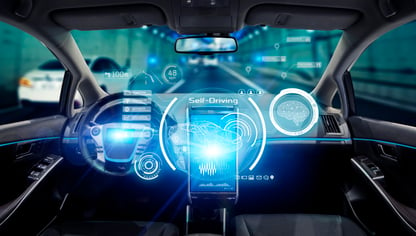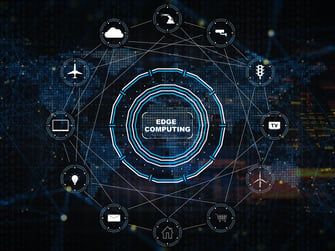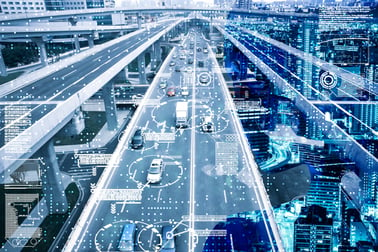Edge Computing is seen by many as the next revolution for processing data. Advancements in technologies such as the Internet of Things (IoT) and 5G will fuel Edge Computing and make it a reality for almost every business. It brings processing power to everyday objects and incredibly detailed analytics that will enable organisations of every shape, size and sector to develop compelling new propositions that are more efficient and deliver a better experience for customers, patients and citizens.
 What is Edge Computing?
What is Edge Computing?
It’s all about extending the boundaries of your network further and further out. Taking computing power to where data is created, collated and acted on, for example, utilising IoT devices and sensor-based technology. Emerging technologies, faster communications (like 5G) and processing power on ever smaller devices make this a truly exciting proposition. This provides great new opportunities, but also brings competitive threats and interesting challenges around data handling, security, privacy and the role of Artificial Intelligence (AI).
For example, autonomous vehicles need to be aware and act on the rapidly changing environment around them. They have to be able to collect vast volumes of data and act upon this instantaneously to keep a car safely on the road and progressing happily to its destination.
In a driverless car the computing power needs to be as close to the data as possible so the right split-second, life or death decisions can be made. The car also needs to stay connected to a central hub so that selected data can be passed back to enable centralised analytics about this vehicle and the wider population of cars – for example, to collect information on traffic conditions; to identify potential engineering issues across the fleet; to collate data on driver interaction with the car to help improve future designs.
Processing Power Closer to the Action
Edge Computing brings computing power and data storage closer to the location where it is needed, sometimes using the public cloud to store and process data, to improve response times and save bandwidth.
Areas where this type of approach are already making an impact include intelligent traffic management systems, where lanes are opened or closed depending on weight of traffic, and emergency services are automatically alerted in the event of breakdowns or accidents. Augmented and virtual reality, where fans can watch sports events and see additional information about players (how fast is the footballer running, how many goals have they scored this season), or gamers hunting pokemon, both of which need information in realtime to deliver the required user experience.
Another potentially life saving example is in hospitals where patients in high dependency units are fitted with intelligent sensors to monitor their vital signs (heart rate, temperature, blood pressure etc) called eObservations, that alert staff should there be a change in the patient’s condition.
Better Handling of Data - The Benefits
As well as the ability to deliver exciting new products, services, and experiences, Edge Computing also delivers a wealth of other, very tangible benefits to the organisation.
- Savings in the cost of resourcing and managing networks. Less data needlessly travelling across the network, means that bandwidth is preserved for applications that can’t be processed locally
- Tighter security. Processing data locally means a smaller attack surface, and with data widely distributed, attacks are harder to orchestrate. In the event of a successful attack, segments of the network can be closed down more easily, protecting the rest of the network. More sensitive, personally identifiable data can be stored closer to the source, which makes access to that data harder, and the central servers less of a target because they hold less of the lucrative information
- Data management. With data distributed across many different locations, storage becomes easier because it is held locally. Processing takes place locally, leaving the analysis of the data, that provides key insights and intelligence, to be managed centrally, avoiding the traditional ‘silos’ of data.


Getting the Most out of your Data
What should you be doing now to prepare your organisation to exploit the potential of Edge Computing? It’s time to start to formulate a vision and a strategy. You can start with a dream or opportunity and work back to how you can achieve it or start with the technology and imagine what the new possibilities will enable your organisation to achieve.
The key steps to consider are:
- Understanding your current position - what data you have, where it is stored, who uses it, in short, mapping out how data drives your current business processes
- Envisioning what it is you are trying to achieve - new products or services, new ways of using your data, providing a more compelling customer experience to drive loyalty
- Developing a strategic plan to bring your vision to life - one that ensures you are able to derive value from your data
Whichever way you approach it, it’s all about the data not the datacentre. Edge Computing provides new and faster ways to collate, analyse and act on data in the most appropriate places, closer to the action. Mapping your existing data landscape and assessing the new opportunities emerging, will enable organisations to use data more efficiently, in short, deriving more value from data, for the business, consumers and the community.
Edge Computing Powers Digital Transformation
With new opportunities come new challenges. Semi-autonomous devices with the real ability to make decisions and act will be located in unpredictable environments. Organisations need to think clearly now about how they will manage this increased complexity.
As the entire business ecosystem embraces digital transformation, new ways to handle device failures, downtime, fixes and software updates will be needed – ideally via the right common tool set.
In future blogs we’ll look deeper at how to take advantage of the new opportunities Edge Computing can bring; how to analyse and map your data landscape; how to address issues around security and data privacy; and how to successfully navigate your digital transformation journey.

Ashminder Ubhi, Category Lead - Core Datacentre at CDW.
For any enquiries contact: info@uk.cdw.com | 020 7791 6000
